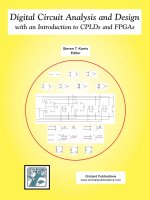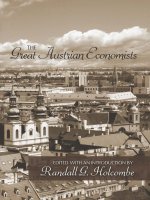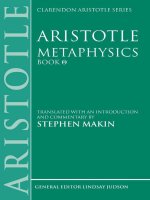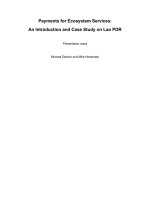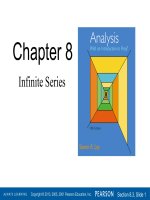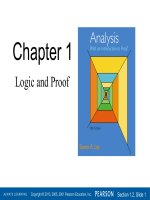- Trang chủ >>
- Khoa Học Tự Nhiên >>
- Vật lý
aristotle metaphysics theta translated with an introduction and commentary nov 2006
Bạn đang xem bản rút gọn của tài liệu. Xem và tải ngay bản đầy đủ của tài liệu tại đây (1.29 MB, 332 trang )
CLARENDON ARISTOTLE SERIES
General Editor
LINDSAY JUDSON
Also published in this series
Categories and De Interpretatione j. l. ackrill
De Anima books I I and I I I d. w. haml y n
New impression with supplementary material by Christopher Shields
De Generatione et Corruptione c. j. f. williams
De Partibus Animalium IandDe Generatione Animalium I d. m. balme
New impression with supplementary material by Allan Gotthelf
Eudemian Ethics Books I, I I, and VII I michael woods
Second edition
Metaphysics Books B and K 1 –2 arthur madigan, sj
Metaphysics Books Γ, ∆,andE christopher kirwan
Second edition
Metaphysics Books Z and H david bostock
Metaphysics Books M and N julia annas
Nicomachean Ethics Books I I–I V c. c. w. tay l o r
Nicomachean Ethics Books V I I I and I X michael pakaluk
On the Parts of Animals james g. lennox
Physics Books I and II william charlton
New impression with supplementary material
Physics Books I I I and I V edward hussey
New impression with supplementary material
Physics Book V I I I daniel graham
Politics Books I and II trevor j. saunders
Politics Books I I I and I V richard robinson
New impression with supplementary material by David Keyt
Politics Books V and VI david keyt
Politics Books VII and VIII richard kraut
Posterior Analytics jonathan barnes
Second edition
Topics Books I and VI I I robin smith
Other volumes are in preparation
ARISTOTLE
Metaphysics
Book
Translated
with an Introduction
and Commentary
by
STEPHEN MAKIN
CLARENDON PRESS · OXFORD
2006
1
Great Clarendon Street, Oxford ox2 6dp
Oxford University Press is a department of the University of Oxford.
It furthers the University’s objective of excellence in research, scholarship,
and education by publishing worldwide in
Oxford New York
Auckland Cape Town Dar es Salaam Hong Kong Karachi
Kuala Lumpur Madrid Melbourne Mexico City Nairobi
New Delhi Shanghai Taipei Toronto
With offices in
Argentina Austria Brazil Chile Czech Republic France Greece
Guatemala Hungary Italy Japan Poland Portugal Singapore
South Korea Switzerland Thailand Turkey Ukraine Vietnam
Oxford is a registered trade mark of Oxford University Press
in the UK and in certain other countries
Published in the United States
by Oxford University Press Inc., New York
© Stephen Makin 2006
Themoralrightsoftheauthorhavebeenasserted
Database right Oxford University Press (maker)
First published 2006
All rights reserved. No part of this publication may be reproduced,
stored in a retrieval system, or transmitted, in any form or by any means,
without the prior permission in writing of Oxford University Press,
or as expressly permitted by law, or under terms agreed with the appropriate
reprographics rights organization. Enquiries concerning reproduction
outside the scope of the above should be sent to the Rights Department,
Oxford University Press, at the address above
You must not circulate this book in any other binding or cover
and you must impose the same condition on any acquirer
British Library Cataloguing in Publication Data
Data available
Library of Congress Cataloging in Publication Data
Data available
Typeset by Laserwords Private Limited, Chennai, India
Printed in Great Britain
on acid-free paper by
Biddles Ltd., King’s Lynn, Norfolk
ISBN 0 –19–875107–9 978–0–19–875107–6
ISBN 0–19–875108–7 (Pbk.) 978–0–19–875108–3 (Pbk.)
13579108642
For Cyril Makin
1924-2003
This page intentionally left blank
PREFACE
This book has been quite some time in the writing, and many people
have provided comments and assistance over the years. I would like
to thank them all. Robert Wardy has given me detailed comments
and invaluable advice on every aspect of the project. The book owes
a great deal to him. Lindsay Judson has read numerous drafts, and
his input has made this a better contribution to the Clarendon
Aristotle series than it would otherwise have been. I have benefited
greatly from the comments of Tad Brennan, Sarah Broadie, Myles
Burnyeat, Nick Denyer, Kit Fine, Doug Hutchinson, Sean Kelsey,
Stephen Menn, David Sedley and Charlotte Witt. I am extremely
grateful to all these friends and colleagues.
Material from this book has been presented to the Aristotelian
Society Joint Session, and to seminars at Cambridge, Nottingham
and Sheffield. Many thanks for the questions and contributions of
those audiences. I would also like to thank the students at Sheffield
University who have attended and contributed to lecture courses on
Metaphysics Θ.
I could not have finished this book without the support of the
Philosophy Department at Sheffield University, who generously
provided more than one period of research leave. I am grateful to
them, and to the AHRB for a Research Leave award.
I have received much help from Oxford University Press, and I
would like to thank especially Jenni Craig, Andrew Hawkey, Peter
Momtchiloff and Hilary Walford.
Ispenttheyear2003 on study leave, funded by the University of
Sheffield and by the AHRB. During that year I thoroughly revised
earlier partial drafts of the book, and I wrote material for those
chapters which were then undrafted. By the end of 2003 Ihadmy
first complete version. In December 2003 my father passed away.
He was a fine person. He gave me his unconditional and unstinting
support throughout my life. This book is for him, in thanks for
everything he ever did for me.
vii
This page intentionally left blank
CONTENTS
INTRODUCTION xi
TRANSLATION 1
COMMENTARY
Chapter 117
Chapter 237
Chapter 360
Chapter 482
Chapter 5 97
Chapter 6 128
Chapter 7155
Chapter 8 181
Chapter 9 221
Chapter 10 247
TEXTUAL NOTES 271
REFERENCES 274
INDEX LOCORUM 281
GENERAL INDEX 287
ix
This page intentionally left blank
INTRODUCTION
1. AN OVERVIEW OF METAPHYSICS Θ
In a way it is easy to state the aim of Aristotle’s Metaphysics Θ.The
book explores the distinction between actuality and potentiality,
between being actually φ and being potentially φ, between the actual
and the potential. Many difficult questions about the aim of Θ
remain: for example, why Aristotle should want to investigate that
distinction, and how Θ should be located within the Metaphysics
as a whole. But it is both possible and useful to set out the main
arrangement of material in Θ before turning to those difficulties.
The chapter breaks of Metaphysics are neither Aristotelian nor
ancient. Chapter divisions did appear in some medieval Latin trans-
lations (both in manuscripts and in printings). However, there
were sometimes alternative chapter divisions for the works that
were arranged into chapters, and not all works in the corpus
were so arranged. The Greek text of the entire corpus was first
divided into chapters under the direction of Simon Grynaeus, in
the third ‘Erasmus’ edition prepared under Grynaeus’s direction
in Basel in 1550 (so called because Erasmus was persuaded to
write a preface). Grynaeus’s motive was convenience of reference.
In some cases he took chapter breaks over from previous Latin
translations; in some cases he chose between alternative chapter
divisions; and in the case of some texts, which had been unknown
in medieval times, he introduced his own chapter structure. In the
case of Metaphysics Grynaeus borrowed from Cardinal Bessarion’s
mid-fifteenth-century (1447–50) Latin translation of Aristotle’s
Metaphysics.
It is important not to overestimate the authority of the chapter
divisions. However, they are not arbitrary (unlike, in this respect, the
convenient line references, which correspond to the page, column,
and line number of the text in Bekker’s nineteenth-century edition
of Aristotle: Metaphysics Θ runs from 1045
b
27 to 1052
a
11). The
chapter breaks are intelligent and sensible, and mark out some
striking broad divisions of the text. Metaphysics Θ is split into ten
chapters, and these fall into three main parts:
xi
introduction
1. Chapters 1–5;
2. Chapters 6–9;
3.Chapter10.
Chapter 10 is about truth and falsity. It is tangential to the body
of Θ. I will postpone further discussion of Θ10 until my detailed
chapter comments. I concentrate for now on Θ1–9.
A division between Chapters 1–5 and 6–9 stands out on first
reading the text, and reflects the structure Aristotle announces
for Θ (1045
b
34–1046
a
4). The potentiality–actuality distinction is
very general and of wide application. In the discussion of sensible
substances in Metaphysics H it was connected with the pervas-
ive form–matter distinction (H 1, 1042
a
27–8; H 2, 1042
b
9–11,
1043
a
5–7, 1043
a
12–28; H 3, 1043
a
29–37; H 5, 1044
b
29–1045
a
6;
H 6, 1045
a
23–35, 1045
b
16–23). In Metaphysics Λ5 actuality
and potentiality are said to provide some sort of common pat-
tern of explanation applying to sensible substances (1071
a
3–17).
As Metaphysics Λ proceeds to non-sensible, indestructible, and
unchangeable substances, form and matter drop out of the pic-
ture, and the argument is pursued in terms of potentiality–actuality
(Λ6, 1071
b
12–1072
a
4; Λ7, 1072
a
24–6, 1072
a
30–2, 1072
b
13–30).
And potentiality–actuality turns up in Metaphysics B’s statement
of abstract problems to be dealt with by first philosophy (B1,
996
a
10–11; B6, 1002
b
32–1003
a
5).
Not all applications of the distinction are as abstract as these, how-
ever. For example, it is hard to understand what change is because it
is hard to locate change within the potentiality–actuality dichotomy
(Phys. 3.2, 201
b
24–202
a
3); nevertheless, change can be defined in
terms of actuality and potentiality (Phys. 3.1 passim,esp.201
a
27–9),
and the distinction could have been used to resolve Presocratic argu-
ments that change is impossible (Phys. 1.8, 191
b
27–9). Potentiality
and actuality are used in accounts of acting and being affected (GC
1.9), material combination (GC 1.10, 327
b
22–31), the soul (An.
2.1), and perception (An. 2.5).
The fact that Aristotle applies the potentiality–actuality distinc-
tion so broadly has three important consequences.
First, Aristotle is extending and developing the notions in using
them so widely. For one side of the dichotomy he has to invent
new terms (§4 on actuality, fulfilment); for the other he has to
use existing terms in new ways (§3 on capacity, potentiality). Some
xii
introduction
applications will be more familiar than others. That is why Aristotle
starts in Chapters 1–5, with the clearest exemplar of potential-
ity–actuality, the relation between a capacity for change and the
changes to which it gives rise (Θ1, 1045
b
35–1046
a
2). The more
familiar and clear cases will elucidate the more novel and opaque
instances of the potentiality–actuality distinction (Θ1, 1046
a
2–4;
Θ3, 1047
a
30–1047
b
2; Θ6, 1048
a
25–30).
Secondly, even the more familiar capacity–change relation covers
a huge range of cases. There are logical distinctions that are hard to
mark without appropriate terminology (§3 on ‘capable’ and ‘possible’
as translations of the Greek adjective dunaton). And there are many
different types of capacity: active and passive, one way and two way,
non-rational and rational, innate and acquired, those acquired by
learning and those acquired by practice. Aristotle needs to bring
order to this material if he is to have any hope of reaching interesting
conclusions about the more familiar capacity–change relation.
Thirdly, if the capacity–change relation is to serve as a clear case,
then it has to be a secure case too. If doubt can be cast on what
are supposed to be the clearest cases of the potentiality–actuality
distinction—for example, on the viability of the distinction between
and someone capable of building but not presently doing so and
someone actually building—then those cases will be useless as a way
into the more difficult applications—for example, form and matter.
Those three consequences shape the main blocks of material in
the first part of Metaphysics Θ, Chapters 1–5.
Θ1 Aristotle explains the structure of the discussion to come,
and the reason for focusing initially on the capacity–change
relation (1045
b
32–1046
a
4). The discussion of capacities
starts with the exclusion of marginal cases (1046
a
6–9).
A wide variety of types of capacity are analysed by identifying
the active capacity of an agent to bring about a change
in something else as the central case (1046
a
9–11), and
connecting all the other cases to that one ( 1046
a
11–19).
There is a careful account of the distinction between an
active capacity and the most significant secondary case of a
passive capacity (1046
a
19–29).
Θ2 Aristotle prepares for the account in Θ5 of the relation
between active and passive capacities, on the one hand, and
the changes to which they give rise, on the other.
xiii
introduction
Two distinctions are presented: non-rational versus rational
capacities (1046
a
36–1046
b
4), and one-way versus two-way
capacities (1046
b
4–7). Aristotle argues that those two dis-
tinctions align with one another (1046
b
4–15).
He makes correlative points about agents that possess the
different types of capacity (1046
b
15–24).
Θ3 Aristotle argues against the deflationary view that there is
no genuine capacity–change distinction: that agents never
possess unexercised capacities (1046
b
29–1047
a
29).
If that deflationary view is false, there is a genuine distinc-
tion between what an agent is capable of and what it is actually
doing, and more generally between what is possible and what
is actual (1047
a
17–24). So Aristotle provides a way of estab-
lishing whether something is possible (1047
a
24–9).
Θ4 The distinction between what is possible and what is actual
is further vindicated by showing that there is also a genuine
difference within what is non-actual between the possible
and the impossible (1047
b
3–14).
Θ5 General conclusions are established about the capacity–
change relation. As regards one-way capacities: necessarily
if agent and patient are in the right condition and related
in the right way, then action results (1047
b
35–1048
a
7).
As regards two-way capacities: necessarily if agent and
patient are in the right condition and related in the right
way, and the agent chooses to act, then action results
(1048
a
7–15).
These general conclusions are further explored and bol-
stered (1048
a
15–24).
The first part of Metaphysics Θ establishes important conclusions
about the capacity–change relation. Since agents still possess capa-
cities even when they are not exercising them, the capacity–change
relation exemplifies a real difference between potentiality and actu-
ality. But capacities inevitably and necessarily give rise to changes
in the right circumstances. That fact about the capacity–change
relation is of great significance in the second part of Metaphysics
Θ, where what is at issue is the potentiality–actuality distinction
conceived more generally: it underpins the conclusions in the latter
parts of Θ8 about the priority of actuality over potentiality (Θ8,
1050
a
4–1050
b
6, 1050
b
6–1051
a
3).
xiv
introduction
Before turning to Θ6–9, notice that the outline of Chapters 1–5
above does not cover the complete text. There are a number of
passages in Θ that do not integrate well with their immediate
context. With one notable exception in the second part of Θ (Θ6,
1048
b
18–35), there is absolutely no reason to be suspicious of
their textual status. Such passages are often found immediately
preceding the Bessarion/Grynaeus chapter breaks. At the end of
Chapter 1 there is a summary comment on different types of inca-
pacity (1046
a
29–31), leading on to some remarks on privation
(1046
a
31–5). Chapter 2 closes with some remarks on the relation
between the capacity for doing something well and the capacity for
doing something simpliciter (1046
b
24–8). At the end of Chapter 3
there is a passage concerning the extension of the term actuality
from its original application, leading to some comments on the status
of what-is-not (1047
a
30–1047
b
2). And more than half of Chapter 4
is devoted to arguing for two related modal theses (1047
b
14–30).
Similarly peripheral passages are found in Chapters 6–9. These pas-
sages are invariably interesting in their own right, and are sometimes
extremely important.
The second part of Θ, Chapters 6 –9, extends the discussion in
Chapters 1–5 of the clearest exemplar of the potentiality–actuality
distinction (that is, capacity–change). The aim is to make headway
with the more opaque applications. These extended applications are
the main concern of Θ (Θ1, 1045
b
36–1046
a
1; Θ6, 1048
a
28–30).
Aristotle has to tread a careful path. On the one hand, the
same potentiality–actuality distinction is exemplified in the capa-
city–change and matter–substance relations (Θ6, 1048
b
4–6): that
is why Chapters 1–5 can serve as preparation for Chapters 6–9.On
the other hand, the two types of case are very different exempli-
fications (Θ6, 1048
b
6–9): that is why the second is an extension
beyond the first, and why Chapters 6–9 need Chapters 1–5 as pre-
paration. The way in which the capacity–change case exemplifies
the distinction of the potential and the actual is quite different from
the way in which the matter–substance case manifests that same
distinction.
The main blocks of material in the second part of Metaphysics Θ
are arranged as follows:
Θ6 Aristotle rehearses the reasons for starting with a discussion
of the capacity–change case (1048
a
25–30).
xv
introduction
There are two attempts to elucidate the general poten-
tiality–actuality distinction (1048
a
30–5, 1048
a
35–1048
b
4).
The second is more successful than the first, because there
Aristotle lays out different cases side by side and invites
us to see the analogies between them. He also comments
explicitly on the respect in which the two types of case
(capacity–change, matter–substance) do exemplify a single
general pattern (1048
b
4–9).
Θ7 Having introduced the general potentiality–actuality distinc-
tion, Aristotle can clarify its new and difficult applications
through consideration of a specific question: under what
conditions is something potentially (F). He again cites the
parallels between the extended applications and the more
familiar capacity–change case (1048
b
37–1049
a
5).
Aristotle’s position (1049
a
5–18) is that something is
potentially F so long as it is a suitable starting point for
the production of something actually F by means of some
appropriate capacity. He details three cases: rational capa-
cities (1049
a
5–11), capacities for change more generally
(1049
a
11–12), and natures (1049
a
13–18).
It follows that the (immediate) matter of an F is poten-
tially an F. This is an important result. Aristotle bolsters it
by appeal to some linguistic data (1049
a
18–24), and draws
some corollaries (1049
a
24–1049
b
2).
Θ8 This is the longest chapter of Θ.ItbuildsonΘ5 (the capa-
city–change relation) and Θ6 –7 (the extended application
that takes in the matter–substance relation) to explain a
general feature of the potentiality–actuality distinction. The
wide variety of cases covered by the discussion is emphas-
ized throughout (1049
b
4–10 both capacities for change
and natures; 1050
a
15–23 matter and form; 1050
b
6–1051
a
3
perishable and eternal things).
Actuality is prior to potentiality (1049
b
5). Three types of
priority are considered: priority in account, in time, and in
substance (1049
b
10–12: w hat these come to is fairly clear
in the first two cases, but not in the third).
What is actually F is prior in account to what is potentially
F(1049
b
12–17).
xvi
introduction
What is actually F is in one way temporally prior to what
is potentially F, and in another way temporally posterior
(1049
b
17–1050
a
3).
The bulk of the chapter concerns priority in substance
(1050
a
4–1051
a
2). Twotypesofcaseareconsidered (1050
a
4–
1050
b
6, 1050
b
6–1051
a
2).
In the first type of case the items that are actually and
potentially F are perishable items from within the natural
world. The substantial priority of what is actually F over
what is potentially F is exhibited in the relation of: mature to
immature specimens (1050
a
4–9); something’s exercising a
capacity to its possessing that capacity (1050
a
9–14); sub-
stance to matter (1050
a
15–23); and exercise to capacity
(1050
a
23–1050
b
2).
Inthesecondtypeofcase(1050
b
6–1051
a
2) the items that
are actually F are eternal things (for example, the sun and
stars), those that are potentially F are destructible things.
Θ9 The priority of what is actually F is reinforced first in
evaluative, and second in epistemic, terms.
In evaluative terms: if a capacity to φ is a good capacity,
then actual φ-ing is better than inactive possession of the
capacity to φ (1051
a
4–15); and, if the capacity to φ is a bad
capacity, then actual φ-ing is worse than inactive possession
of the capacity to φ (1051
a
15–21).
In epistemic terms: geometrical proof proceeds by actual-
izing, and thereby making apparent, constructions that had
been potential (1051
a
21–33).
The main omissions from the outline of Θ6–9 above are two blocks
of material from Θ6. One is of lesser importance: 1048
b
9–17 con-
cerns the status of the infinite and the void. But the second is of much
greater significance, and its absence from the outline of Θ6–9 is far
more striking. The passage 1048
b
18–35 introduces a well-known
Aristotelian distinction between incomplete and complete changes.
Incomplete changes are directed to a result beyond themselves and
are incomplete until that result is achieved (as house building is
directed towards houses, and walking to being in a certain location).
In contrast, a complete change is not directed to a distinct result,
xvii
introduction
and is complete at any and every point (as seeing does not require
a result outside itself to finish it off). This distinction is, in itself,
both interesting and important. What is not clear is how significant
it is for the overall argument of Metaphysics Θ.Onemainreason
why that is not clear is that the textual status of 1048
b
18–35 is
controversial. There is more detailed discussion at Commentary,
Chapter 6,§§6, 7.
Another introductory point. Throughout this Commentary I talk
about the relation both between a capacity and a change and between
a capacity and its exercise. This is deliberate, and should not mislead.
There is an important difference between the exercise of a capacity
and the exercising of a capacity. I say very little about the latter
notion. The exercising of a capacity is the transition from its inactive
possession to its active exercise. The metaphysical status of this
exercising is opaque. I do not mean to suggest that the exercising
of a capacity is a change, and I think it unlikely that Aristotle
believed that it was (see Commentary, Chapter 6,§7,onAristotle’s
discussion at An. 2.5, 417
a
21–417
b
6, of the difference between two
types of transition: in terms of the distinction explained there, it
is likely that the exercising of a capacity will be an example of the
second type of transition in which the potential is preserved in,
rather than being replaced by, the actual). By contrast, the exercise
of a capacity is not the transition from the inactive possession of
a capacity to anything at all—it is, rather, that to which there is a
transition. Why not simply use the term change for that item? There
are two main reasons. First, it is not just any old change that is
relevant in a particular case. Maybe when a fire starts to heat oil all
sorts of changes occur in the oil (for example, changes of colour and
viscosity). It is not those changes that stand to the fire’s capacity to
heat as the actual to the potential, but rather the rise in temperature
in the oil: that is to say, the change that is associated in a certain way
with the capacity—namely, in virtue of being its exercise. Second,
Aristotle will mention cases in which it will be awkward to talk of
the exercise of a capacity as a change (Θ5, 1047
b
32, the capacity to
play the flute: the exercise of that capacity is flute playing, but it is
not clear that flute playing is a change—and it would beg too many
questions to assume that the distinction at Θ6, 1048
b
18–35,canbe
wheeled in throughout Metaphysics Θ). For both these reasons it
will sometimes be very helpful to talk of the exercise of a capacity.
xviii
introduction
2. HOW TO READ METAPHYSICS Θ
Aristotle’s Metaphysics,asithascomedowntous,consistsof
fourteen books. The orthodoxy is that it is the product of some
sort of editorial work on treatises that were originally distinct,
although authoritative ancient evidence on this editing is surpris-
ingly scanty (Menn 1995). There is considerable disagreement
about the chronological and logical relations between the differ-
ent books. Some of the books seem self-contained, and are prime
contenders for intruder status into the Metaphysics as we have
it now: most notably
α, ∆,andK. Others fall into more nat-
ural sequences, although details are disputed. It is commonly
agreed that Θ is not an independent treatise. But, since there
is no agreement on the structure of the books within which
it is embedded, a commentary devoted to Θ faces a pervasive
difficulty.
The details of Θ’s internal structure are difficult. Given that, a
good way to proceed would be to follow guiding lines of argument in
steering a path through Θ.SinceΘ does not stand alone, those lines
of argument are certain to integrate Θ somehow with surrounding
books. But any substantive account of how the other books of the
Metaphysics are related to one another will be controversial, while
any account that avoids controversy by avoiding bold claims will fail
to provide real help with the opaque internal structure of Θ.
So it might be better if we could be guided by lines of argument that
start at the beginning of Θ itself. There would still be disagreement
on how to fit in the books that are downstream of Θ, but there is
no reason why those questions should be decided in a commentary
on Θ. That is the sort of position we are in with the notoriously
difficult book Z.WhileZ has connections with other books of the
Metaphysics, Z1–2 seem to explain and introduce a fairly large-scale
project. However, the case of Θ is different. It has to be understood,
at least to some degree, in the light of questions set by a project
already under way when the book starts.
So how should a commentary on Θ proceed? One option would
be to outline the leading candidate accounts of the overall structure
of the Metaphysics, explain in detail how individual chapters of Θ
would be understood differently in the light of different accounts,
and maintain a studied neutrality throughout. But that would turn
this commentary into a catalogue of possibilities, whereas the hope
xix
introduction
is genuinely to engage with, rather than just describe different ways
in which one could engage with, the arguments of Θ.
Another option would be to adopt one’s favoured account without
argument, ignore its problems and the alternative candidates, and get
started at the first sentence. But that would give a false impression
of the difficulties of interpreting Θ,andintheeyesofsomereaders
would beg too many important questions.
A third option would be simultaneously to rely on and defend an
account of the main lines of argument that structure Θ.But,since
Θ is not the start of the overall argument, a commentary on Θ itself
is not the place to start the defence of one guiding argument over
another.
It is good for a reader to be aware of these issues before approach-
ing the text. All I will do here is describe in broad outline some
different ways of relating Θ to the immediately surrounding book
of the Metaphysics. As Aristotle says, it helps to be aware of the
difficulties of a project before embarking on it (Metaphysics B1,
995
a
27–995
b
4).
One perspective on Metaphysics Θ is the following. The concern
of the Metaphysics is being or what is.But,asAristotlerepeatedly
remarks, ‘being is said in many ways’. There is a brief and program-
matic classification at Metaphysics ∆7 (see Kirwan 1971 for further
comment). Things are said to be
1. 1017
a
8–22: accidentally;
2. 1017
a
22–30: i n their own right, as indicated by the different
categories;
3. 1017
a
31–5: in that they are true or false;
4. 1017
a
35–1017
b
9: in that they are potentially and actually.
Metaphysics E1 is a difficult discussion of the nature of first or
primary philosophy, which will study being qua being—what it is,
and the attributes that belong to it qua being (E1, 1026
a
31–2). The
fourfold classification of Metaphysics ∆7 then reappears at the start
of Metaphysics E2 (E2, 1026
a
33–1026
b
2). So one might expect
any study of being (whatever that study turns out to be) to follow
four lines of enquiry corresponding to the fourfold classification.
Those four lines would be pursued though Metaphysics E –Θ as
follows:
xx
introduction
1. Metaphysics E2–3: accidental being;
2. Metaphysics Z –H : categorial being (with the emphasis on the
primary category, substance);
3. Metaphysics E4, Θ10: being as truth and falsity;
4. Metaphysics Θ1–9: being potentially and actually.
On this approach Θ would be the start of a local line of enquiry
that was itself one of a broader set of enquiries within the grander
project of the Metaphysics.
A second perspective concentrates on Θ as contributing to the
resolution of problems bequeathed it from elsewhere, most notably
the immediately preceding books Z and H . Metaphysics Z poses the
question ‘what is substance?’ (Z1, 1028
b
2–4). In the course of the
complex discussion in Z and the following book H , a number of
conditions on something’s being a substance are identified. One of
these is that a substance should be a unity, rather than a collection of
other things. But it also emerges that concrete individuals—which,
at the very least, have a strong claim to be substances—are com-
plexes, for example of form and matter. Aristotle’s treatment of this
issue in Metaphysics H 6 turns, in one way or another, on connecting
form with actuality and matter with potentiality, and referring the
unity of form and matter to the unity of actuality and potentiality
(for more detailed discussion, see §6 below). But clarifying issues
concerning form and matter in terms of actuality and potentiality
incurs a further cost. Aristotle now has to clarify the notions of
actuality and potentiality, and in ways that show how they can fulfil
the dialectical task set them. On this approach an important concern
in Metaphysics Θ will be to show how it is that form and actuality,
and matter and potentiality, are connected, and how the unity of the
actual and the potential is any more perspicuous than the unity of
form and matter that it is intended to explain.
These two are not the only ways of connecting Θ with other
books of the Metaphysics (see Frede 1994: 174–6 for discussion).
For example, Θ has looser connections with the problems raised in
Metaphysics B (see B1, 996
a
10–11; B6, 1002
b
32–1003
a
5; Madigan
1999 for comment). And the notions of actuality and potentiality that
are the subject of Θ are important for the project of Metaphysics Λ.
Later in this Introduction (§§6, 7) I will outline two sets of
problems to which Metaphysics Θ contributes. One concerns issues
about the unity of substance, inherited from Metaphysics H .The
xxi
introduction
other focuses on the metaphysical project Aristotle pursues in
Metaphysics Λ. In b oth cases the aim is to motivate these problems
for readers who are not predisposed to be interested in Aristotle,
and to give those readers a way into Θ. I hope I can pursue that
aim while finessing intractable questions about the place of Θ in the
Metaphysics.
3. ARISTOTLE’S MODAL TERMINOLOGY (1):
POSSIBILITY AND CAPACITY
At the core of Metaphysics Θ is the contrast between potentiality
and actuality. It is important to say something about the modal
terminology Aristotle has at his disposal to express and discuss that
contrast. The overview in §1 simplified matters considerably. As
regards the potentiality side of the contrast, Aristotle’s vocabulary is
limited. As regards the actuality side, ordinary Greek was even more
inadequate, and Aristotle invented two new words, whose relation to
one another calls for comment.
First, the potentiality terminology. Aristotle uses three related
Greek terms in Metaphysics Θ:
1.averbdunasthai;
2. a noun dunamis;
3.anadjectivedunaton.
A translator’s ideal might seem to be a same-Greek/same-English
strategy throughout Metaphysics Θ, which also preserves the relation
between noun, verb, and adjective. Failing that, a strategy that
permits same-Greek/different-English across Θ as a whole, but
preserves same-Greek/same-English within as large sub-Θ units
as possible, would be attractive. Any decision to translate a single
Greek term by different English terms within small bodies of text
requires justification.
1. The verb is less common than the noun or adjective, and the
uniform translation ‘to be capable’ is attractive. But a correspond-
ing uniform translation for the noun (‘capacity’) and adjective
(‘capable’) is not feasible.
2. The noun is used in both the nominative (dunamis)andthe
dative (dunamei) case. When used in the nominative, it can often
xxii
introduction
be translated as ‘capacity’. For example, an electric kettle has a
capacity (dunamis) to heat water, and medical skill is a two-way
capacity (dunamis) possessed by a doctor to heal or harm patients.
However, the noun is also used in the dative case with adverbial force.
There is no natural rendition in terms of capacity, and translators
have generally opted for potentially. For example, we might ask
whether a fertilized egg or a viable foetus is potentially (dunamei)a
human being, and what conditions are required for something to be
potentially (dunamei) a house.
Now the dative dunamei is far more common in the second part of
Θ than in the first. It occurs twenty-three times in Chapters 6–9,but
only three times in Chapters 1–5 (Θ1, 1046
a
30; Θ2, 1046
b
25; Θ3,
1047
b
1). Since the dative dunamei is naturally translated ‘poten-
tially’, and since the dative predominates in the later chapters of Θ,
it is reasonable to translate the corresponding nominative dunamis
by ‘potentiality’ in those later chapters (for example, Θ8 would
be about the relation between potentiality (dunamis) and actuality
(energeia)).
However, it would not be wise to favour ‘potentiality’ over ‘capa-
city’ as a rendition of the nominative dunamis in the earlier
chapters of Θ. It would be unnecessarily opaque (for example,
the opening of Θ5, 1047
b
31–2, would read ‘as all potentialities
are either innate or come about by habit or by learning’);
and it would miss the contrast with the negative term at Θ1,
1046
a
29–35 (‘capacity’ and ‘incapacity’ have no equivalent in terms
of ‘potentiality’).
So the norm is that the noun dunamis will be translated ‘capacity’
in Θ1–5 and ‘potentiality’ (nominative), ‘potentially’ (dative) in
Θ6–10. The advantage is a high degree of uniformity across very
large sub-Θ blocks of text (Θ1–5, Θ6–10).
However, the uniformity is not total. Aristotle starts Θ1 with
some organizational remarks (1045
b
27–1046
a
9). Only then does
he introduce and define the core notion of an active capacity
(1046
a
10–11). Prior to his doing so it would be misleading to
use the translation ‘capacity’. So I use ‘potentiality’ for the noun
dunamis at 1045
b
33–5, 1046
a
1, 5–6 (with ‘being potential’ for the
verb dunasthai at 1046
a
5, ‘possible/impossible’ for the adjectives
dunata and adunata at 1046
a
8). Another departure is the trans-
lation ‘potentially’ for the adverbial dative at Θ3, 1047
b
1:thisis
in the course of a discussion of actuality, in one of the passages
xxiii
introduction
that is not well integrated with the material that surrounds it.
A third departure is at Θ9, 1051
a
8, ‘the same capacity’, where
Aristotle is making a point about the type of active and passive
capacities that were the subject of Θ1. Further, the high degree
of uniformity that is secured comes at the cost of a few disson-
ant translations. The decision to translate the noun dunamis as
‘capacity’ throughout Θ1–5 causes strain at Θ3, 1047
a
25,and
Θ5, 1048
a
15–16 (see Commentary, Chapter 3,§8,andChapter5,
§10); and the decision to translate dunamis as ‘potentiality’ in
Θ6–10 produces jarring results at Θ6, 1048
b
8 (see Commentary,
Chapter 6,§2).
3. Translation of the adjective dunaton (and the cognate negat-
ive adjective adunaton) raises a different issue. This does not
turn particularly on the transition between Chapters 1–5 and 6–9.
Throughout Θ the translations ‘capable/incapable’ are tempting
at some places, and ‘possible/impossible’ at others. There is no
uniformity across any very large sub-Θ blocks of text. The choice
between ‘(im)possible’ and ‘(in)capable’ does not map onto the
large-scale structure of Θ. It is, rather, a choice recommended by
charity.
First what is the distinction between the (im)possible and the
(in)capable? Start with the rough though intuitive idea of that very
wide range of weak modalities, which includes abilities, capacities,
epistemic licences, ethical permissions, logical possibilities, physical
possibilities, powers, skills, temporal possibilities, tendencies, and
so on. For convenience sake, and by fiat, I will use the term can
neutrally to cover this range of cases (I can play the piano, I can
believe that Princip shot Archduke Ferdinand, we can lie to save the
innocent, sulphuric acid can dissolve zinc, etc.). These are weak
modalities because the fact that I can φ does not entail that I do φ (I
can play the piano but I am not doing so; I can believe that Princip
shot Ferdinand, but I do not).
Now consider this principle:
[T] A φs → Acanφ
We can divide the very wide range of weak modalities between
those for which [T] does and those for which [T] does not hold. For
example, [T] holds for physical possibilities or temporal possibilities
(if the ball is moving at 30 mphthenitphysicallycanmoveat30 mph,
xxiv
